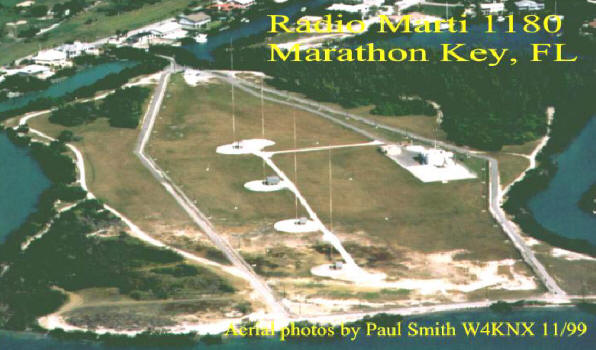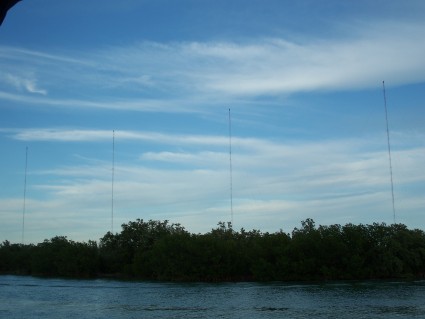|
Radio
Martí 1986 Congress-mandated evaluation |
| In 1986, together with Miami broadcast executive Julio Rumbaut, I was invited to serve as the evaluation consultant for the United States Information Agency's Radio Martí Program. Click on the letter above to see a readable PDF version. |
 |
| In accordance with the Act of Congress which chartered the program, an independent consultant is to be called upon each year to evaluate whether the Martí program is fulfilling its mandate. |
 |
| Radio Marti is the only 100,000 watt medium wave station in the US. The transmitter is located on Key Marithon, and the end-fired directional array pushes a lobe of over 400,000 watts towards Cuba. |
|
Radio Marti transmitted its first broadcast on May
20, 1985, from studios in Washington, D.C. The
broadcast was the culmination of a three-year,
bipartisan effort in Congress that resulted in
passage of the Radio Broadcasting to Cuba Act of
1983 (Public Law 98-111).
By law, Radio Marti programs must be produced in accordance with the standards of the VOA Charter to ensure accuracy, objectivity, and balance in their content. Radio Marti broadcasts seven days a week, 24 hours a day, on medium wave (AM) and shortwave. Broadcasts include news, music, and a variety of feature and news analysis programs. Audience reports based on interviews with Cubans arriving in the United States indicate that Radio Marti is the most popular radio station in Cuba despite the Cuban government's effort to jam it. Radio Martí is named after Cuban intellectual, patriot and writer José Martí. |
 |
| Another view of the transmitter site and the four AM towers. Shortwave is broadcast from VOA in North Carlolina. |
|
An Unauthorized
History of Radio Martí |
|
U.S. broadcasts to Cuba since
Castro's revolution in 1959 has followed a winding path, beginning
with Radio Swan (see
QSL image and summary),
leading to Radio Marti, and encompassing dozens of independent and
CIA-sponsored stations and programs. Oddly enough, Radio Marti
can be tied to both Radio Swan and the still-active La Voz de
Fundacion. Jorge Mas Canosa, former broadcaster with Radio
Swan and president of the
Cuban American National
Foundation (which runs La Voz de
Fundacion), was the head of the presidential advisory board for
Radio Marti during the mid-1980's (Soley). As a tool of public
diplomacy, Radio Marti has been the most effective in affecting
Cuban domestic politics thanks to the lessons US policymakers
learned from Radio Swan. Radio Marti's beginnings can be traced back to a speech in 1981 when US President Reagan declared that it was his administration's intention to establish a Radio Free Cuba that would operate like Radio Free Europe and Radio Liberty. In order to see the station begin, however, its budget had to be passed through the US Congress, and in 1982 the Senate voted down the proposal. A year later legislation did indeed pass through and on October 4, 1983, Ronald Reagan signed the Radio Broadcasting to Cuba Act Public Law 98-111.) Unlike Radio Free Europe and Reagan's original vision, Radio Marti was to be placed under the authority of the Voice of America and "subject to the same limitations of U.S. government controls as is the VOA" (Hansen, p.120). Fidel Castro, along with Liberal members of U.S. Congress, complained. He immediately threatened to broadcast Cuban stations on the same frequencies as commercial U.S. stations on medium wave, and after Radio Marti's inaugural broadcast he cut an immigration agreement with the U.S. government (ibid, p.121). Radio Marti signed on the air on May 20, 1985 on 1160 kHz with 14 1/2 hours of programming from VOA's transmitters in Marathon Key, Florida. Staff of the Radio Marti Office of Research monitors Cuban broadcasts, reviews Cuban publications, talks with Cuban immigrants, defectors and visitors in order to gauge what domestic broadcasts in Cuba lack. "We had to find out what the Cubans were telling their population," Director Ernesto Betancourt explains, "and then determine what information should be made available to them to compensate for the omissions" (ibid, p.120). Over time, programming hours increased and included such items as news, entertainment, soap operas and messages for Cuban-Americans to their relatives back on the island. Even the liberal New York Times capitulated on its initial criticism of Radio Marti after printing an editorial that states "Contrary to our statement, the station appears to have found a responsive audience and filled a void in Cubans' information... It has avoided propaganda and supplemented, not duplicated, commercial Spanish-language broadcasts from Florida" (March 22, 1986 as quoted in Hansen, p.121). Reports from exiles, defectors, and even journalists within Cuba also support the station and give credence to the fact that Radio Marti is the most-listened to radio station on the island. One human rights activist says it provides the "ability to respond to the monologue Fidel Castro has been sustaining with the Cuban people" for decades (Hansen, p.122). A journalist in 1996 said that the Cuban government continues to slander the station "in spite of the fact that its ratings always beats that of the stations which broadcast in the island" (Martinez). The US government had tried its hands at broadcasting propaganda to Cuba with dismal results. Radio Swan was unveiled to support the Bay of Pigs invasion in 1960 but after a few years it became Radio Americas and finally fizzled from the air. These stations lacked an audience effective enough to justify their expenditure, and many people point to their hostile programming and lack of credibility as the cause. Radio Marti, on the other hand, with its Office of Research presents itself as a legitimate international broadcaster that competes with Cuban domestic stations. In fact, Jorge Riopedre argues in an unpublished paper that Radio Marti was a major influence in many political initiatives undertaken in Cuba regarding AIDS and housing (Riopedre). |